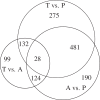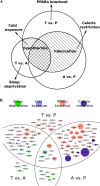Molecular signatures of mammalian hibernation: comparisons with alternative phenotypes
- PMID: 23957789
- PMCID: PMC3751779
- DOI: 10.1186/1471-2164-14-567
Molecular signatures of mammalian hibernation: comparisons with alternative phenotypes
Abstract
Background: Mammalian hibernators display phenotypes similar to physiological responses to calorie restriction and fasting, sleep, cold exposure, and ischemia-reperfusion in non-hibernating species. Whether biochemical changes evident during hibernation have parallels in non-hibernating systems on molecular and genetic levels is unclear.
Results: We identified the molecular signatures of torpor and arousal episodes during hibernation using a custom-designed microarray for the Arctic ground squirrel (Urocitellus parryii) and compared them with molecular signatures of selected mouse phenotypes. Our results indicate that differential gene expression related to metabolism during hibernation is associated with that during calorie restriction and that the nuclear receptor protein PPARα is potentially crucial for metabolic remodeling in torpor. Sleep-wake cycle-related and temperature response genes follow the same expression changes as during the torpor-arousal cycle. Increased fatty acid metabolism occurs during hibernation but not during ischemia-reperfusion injury in mice and, thus, might contribute to protection against ischemia-reperfusion during hibernation.
Conclusions: In this study, we systematically compared hibernation with alternative phenotypes to reveal novel mechanisms that might be used therapeutically in human pathological conditions.
Figures





Similar articles
-
Clock Gene Expression in the Suprachiasmatic Nucleus of Hibernating Arctic Ground Squirrels.J Biol Rhythms. 2017 Jun;32(3):246-256. doi: 10.1177/0748730417702246. Epub 2017 Apr 28. J Biol Rhythms. 2017. PMID: 28452286
-
Shotgun proteomics analysis of hibernating arctic ground squirrels.Mol Cell Proteomics. 2010 Feb;9(2):313-26. doi: 10.1074/mcp.M900260-MCP200. Epub 2009 Nov 20. Mol Cell Proteomics. 2010. PMID: 19955082 Free PMC article.
-
Modulation of gene expression in hibernating arctic ground squirrels.Physiol Genomics. 2008 Jan 17;32(2):170-81. doi: 10.1152/physiolgenomics.00075.2007. Epub 2007 Oct 9. Physiol Genomics. 2008. PMID: 17925484
-
Molecular interactions underpinning the phenotype of hibernation in mammals.J Exp Biol. 2019 Jan 25;222(Pt 2):jeb160606. doi: 10.1242/jeb.160606. J Exp Biol. 2019. PMID: 30683731 Review.
-
How the gut and liver hibernate.Comp Biochem Physiol A Mol Integr Physiol. 2021 Mar;253:110875. doi: 10.1016/j.cbpa.2020.110875. Epub 2020 Dec 25. Comp Biochem Physiol A Mol Integr Physiol. 2021. PMID: 33348019 Free PMC article. Review.
Cited by
-
Adenosine and P1 receptors: Key targets in the regulation of sleep, torpor, and hibernation.Front Pharmacol. 2023 Mar 10;14:1098976. doi: 10.3389/fphar.2023.1098976. eCollection 2023. Front Pharmacol. 2023. PMID: 36969831 Free PMC article. Review.
-
Phagocyte activity reflects mammalian homeo- and hetero-thermic physiological states.BMC Vet Res. 2020 Jul 6;16(1):232. doi: 10.1186/s12917-020-02450-z. BMC Vet Res. 2020. PMID: 32631329 Free PMC article.
-
Hibernation induces widespread transcriptional remodeling in metabolic tissues of the grizzly bear.Commun Biol. 2019 Sep 13;2:336. doi: 10.1038/s42003-019-0574-4. eCollection 2019. Commun Biol. 2019. PMID: 31531397 Free PMC article.
-
Cytoprotection by a naturally occurring variant of ATP5G1 in Arctic ground squirrel neural progenitor cells.Elife. 2020 Oct 14;9:e55578. doi: 10.7554/eLife.55578. Elife. 2020. PMID: 33050999 Free PMC article.
-
Effects of hibernation on bone marrow transcriptome in thirteen-lined ground squirrels.Physiol Genomics. 2016 Jul 1;48(7):513-25. doi: 10.1152/physiolgenomics.00120.2015. Epub 2016 May 20. Physiol Genomics. 2016. PMID: 27207617 Free PMC article.
References
-
- Frerichs K, Smith C, Brenner M, Degracia D, Krause G, Marrone L, Dever T, Hallenbeck J. Suppression of protein synthesis in brain during hibernation involves inhibition of protein initiation and elongation. Proc Natl Acad Sci U S A. 1998;95:14511–14516. doi: 10.1073/pnas.95.24.14511. - DOI - PMC - PubMed
-
- Carey HV, Andrews MT, Martin SL. Mammalian hibernation: cellular and molecular responses to depressed metabolism and low temperature. Physiological reviews. 2003;83:1153–81. - PubMed
Publication types
MeSH terms
Substances
LinkOut - more resources
Full Text Sources
Other Literature Sources
Molecular Biology Databases

